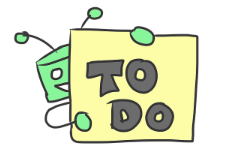Creating To-Do Lists

Creating to-do lists is something we all do. Sticky notes and memo pads are a great invention, but there are ways to do it technologically so that you don't lose those stickies. You can retrieve them anywhere you are with your device. There are ways to be more productive with to-do lists. In this section, you will learn the right way to create your to-do lists so that you actually complete them!
Unfortunately we create lists and we either ignore them or don't complete them. In this session, you are going to learn how to become more productive by creating lists that you will actually complete. Creating lists is the first step in completing goals. If the list is actually written, keyed in or recorded on a device it has a better chance of being remembered and completed.
You can purchase sticky notes or memo pads to create to-do lists, but using technology to create your lists will allow you to access them with a device everywhere. You will also be able to sort, create multiple lists and prioritize tasks easily.
Steps:
1. The first step is to read this article with 15 tips for How to Be More Productive: The Right Way to Create a To-Do list.
2. The next thing to do is to choose an application for creating lists. You should be able to set due dates, reminders, add a sub-task, add a note and file. You can also create a list that is shareable with others.
| Application | Description | Tutorial |
| Apple Notes | Apple Notes is part of the iOS operating system and if you sync your apple devices you can retrieve your notes and lists on all of your devices. | Apple Instant Notes is a Must |
| Google Tasks | Google Tasks is part of the Google Suite and can be used with Gmail and Calendar. When you create a task, you can add details, set a date and time, add subtasks or make it repeat on certain days. You can create up to 100k tasks. | How to Use Google Tasks |
| Microsoft To do | Create daily to-do lists, retrieve them on all your devices, break tasks down into simple steps, add due dates, and set reminders to keep you on track and share with family friends and colleagues. | How to Use To Do |
| Todoist | Use Todoist to keep track of everything you need to get done, organize projects, and plan your day for maximum focus and productivity. | Using Todoist |
| Trello | Trello is a project management tool where you can create lists and tasks and assign them to others | Trello Tutorial |
3. Before you begin using an application you are going to want to read David Allen's Getting Things Done Five Steps ®. David Allen is a popular author, speaker and blogger who has trademarked the saying Getting Things Done. Creating lists is easy to do, but maintaining, prioritizing and completing them is how you become more productive.
4. Your task is to choose an application and create at least one list. You can make a to-do list for your classroom or set the goals for a project you are working on. After reading the two articles in this section, make sure to follow their tips and helpful suggestions for creating meaningful lists.
5. Share your list with your instructor with a reflection on how your list making has changed with the tips you read. Share how you completed the list and achieved your goals.
Move on to the Final Assignment
Standards
Addressing the ISTE Standards For Educators
Learner
1a. Set professional learning goals to explore and apply pedagogical approaches made possible by technology and reflect on their effectiveness.
1c. Stay current with research that supports improved student learning outcomes, including findings from the learning sciences.
Leader
1a. Shape, advance and accelerate a shared vision for empowered learning with technology by engaging with education stakeholders.
2b. Advocate for equitable access to educational technology, digital content and learning opportunities to meet the diverse needs of all students.
2c. Model for colleagues the identification, exploration,
evaluation, curation and adoption of new
digital resources and tools for learning.
Collaborator
4a. Dedicate planning time to collaborate with colleagues to create authentic learning experiences that leverage technology.
4b. Collaborate and co-learn with students to discover and use new digital resources and diagnose and troubleshoot technology issues.
Designer
5a. Use technology to create, adapt and personalize learning experiences that foster independent learning and accommodate learner differences and needs.
Facilitator
6a. Foster a culture where students take ownership of their learning goals and outcomes in both independent and group settings.
6b. Manage the use of technology and student learning strategies in digital platforms, virtual environments, hands-on makerspaces or in the field.
